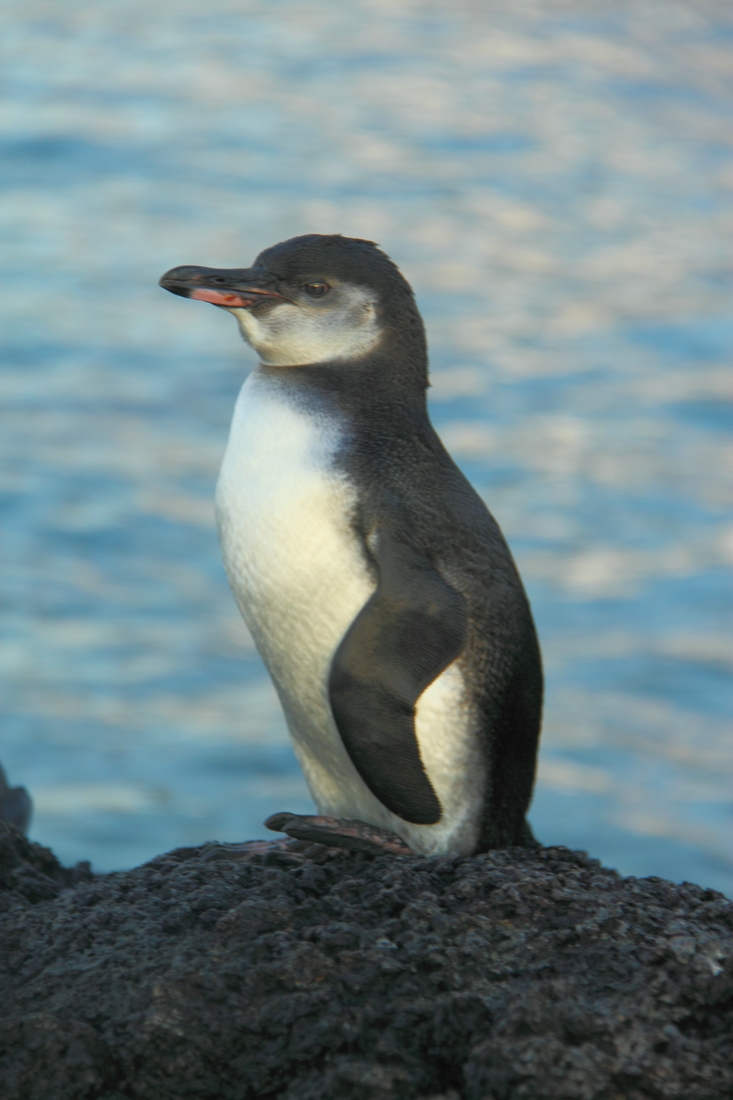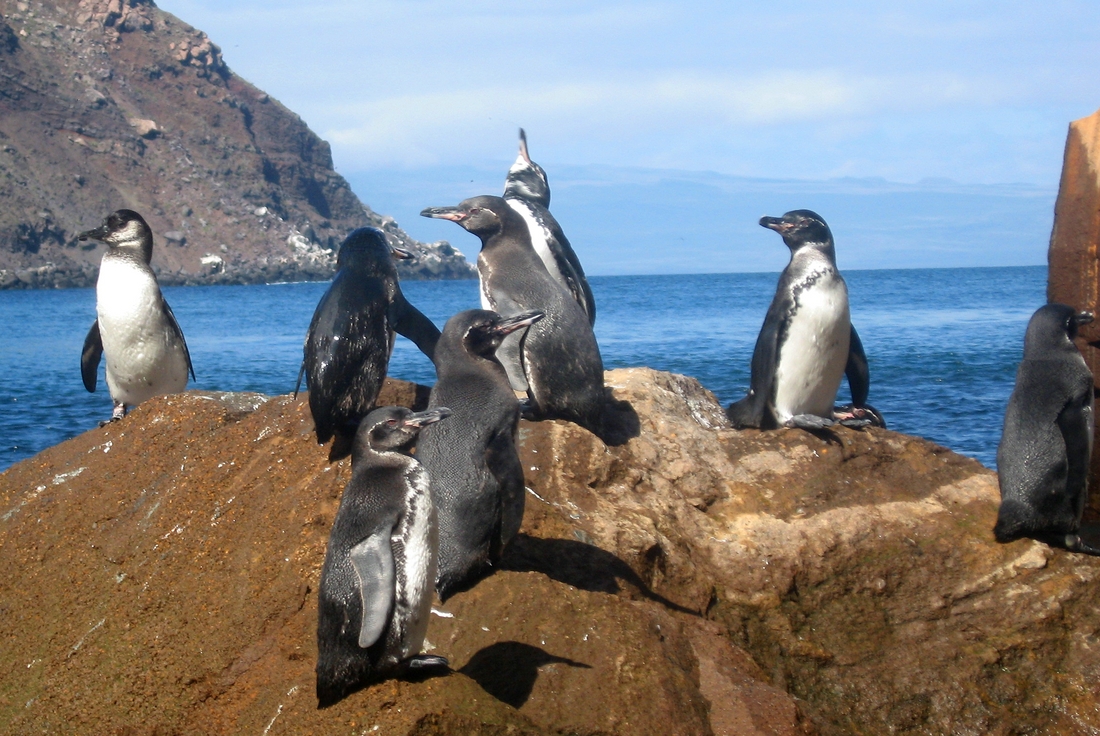Base de Datos de las Especies de Galápagos
La Base de Datos de las Especies de Galápagos comparte la información de las especies de nuestras Colecciones de Historia Natural.
Spheniscus mendiculus
Pingüino de Galápagos, Galapagos Penguin












Es el único pingüino que habita y se reproduce en el trópico. Adulto con alas negras y parte posterior de clor blanco, cola de color negro.
Dominio
Eukaryota
Reino
Animalia
Filo
Chordata
Clase
Aves
Orden
Sphenisciformes
Familia
Spheniscidae
Género
Spheniscus
Especie
mendiculus
Categoría de taxón: Aceptado
Origen: Endémica
Preferencias de alimentación: Se alimentan de peces y crustáceos.
Papel trófico: Carnívoro
Biología reproductiva: La reproducción depende de la disponibilidad de alimento, generalmente colocan 2 huevos los que son incubados por ambos padres durante 40 días.
Distribución: Estan distribuidos en Fernandina, Isabela, Floreana, Santiago (Lougie), Bartolomé, Sombrero Chino. Algunos individios se pueden observar en Santa Cruz, Santa Fe, Baltra, Dhapne y Genovesa.
- Carrera-Játiva Rodríguez-Hidalgo, R., Sevilla, C., & G. Jiménez-Uzcátegui. (2014) Gastrointestinal parasites in the Galápagos Penguin Spheniscus mendiculus and the Flightless Cormorant Phalacrocorax harrisi in the Galápagos Islands. Marine Ornithology 42: 77-80.
- Carrillo, E. Aldás, S., Altamirano, M.A., Ayala-Varela, F., Cisneros-Heredia, D.F., Endara, A., Márquez, C., Morales, M., Nogales-Sornosa, F., Salvador, P., Torres, M.L., Valencia, J., Villamarín-Jurado, F., Yánez-Muñoz, M.H. & Zárate, P. (2005) Lista Roja de los Reptiles del Ecuador. Fundación Novum Milenium, UICN-Sur, UICN-Comité Ecuatoriano, Ministerio de Educación y Cultura, Serie Proyecto PEEPE. Quito, 46 pp.
- Castro, I. Phillips, A. (1996) A Guide to the Birds of the Galapagos Islands. Christopher Helm Publishers Ltd., London.
- Crawford, R. ., Ellenberg, U., Frere, E., Hagen, C., Baird, K., Brewin, P., Crofts, S., Glass, J., Mattern, T., Pompert, J., Ross, K., Kemper, J., Ludynia, K., Sherley, R., Steinfurth, A., Suazo, C., Yorio, P., Tamini, L., Mangel, J., Bugoni, L., Jiménez-Uzcátegui, G., Simeone, A., Luna-Jorquera, G., Gandini, P., Woehler, E., Pütz, K., Dann, P., Chiaradia, A., Small, C. (2017) Tangled and drowned: A global review of penguin bycatch in fisheries. Endangered Species Research. 34: 373-396. doi.org/10.3354/esr00869.
- Deem, S.L. Merkel, J., Ballweber, J., Vargas, F.H., Cruz, M.B., & Parker, P.G. (2010) Exposure to Toxoplasma gondii in Galapagos penguins (Spheniscus mendiculus) and flightless cormorants (Phalacrocorax harrisi) in the Galapagos Islands. Journal of Wildlife Diseases 46: 1005-1011.
- Freile, J.F. Santander, T., Jiménez-Uzcátegui, G., Carrasco, L., Cisneros-Heredia, D., Guevara, E., Sánchez-Nivicela, M., Tinoco, B. (2019) Lista Roja de las aves del Ecuador Quito, Ecuador. 97 pp.
- Granizo, T. Pacheco, C., Rivadeneira, M. B., Guerrero M. & Suárez, L. (eds.) (2002) Libro Rojo de las Aves del Ecuador. SIMBIOE/Conservation International/EcoCiencia/Ministerio del Ambiente/IUCN. Serie Libros Rojos del Ecuador, tomo 2. Quito, Ecuador.
- Harris, M.P. (1973) The Galápagos avifauna. Condor 75(3): 265-278.
- Hickin, N. (1979) Animal life of the Galapagos. Ferundune Books, Faringdon, U.K., 236 pp.
- IUCN (2015) The IUCN Red List of Threatened Species. Version 2015-4. <www.iucnredlist.org>. Downloaded on 20 November 2015.
- Jiménez, E.S. Jiménez-Uzcátegui, G., Egas, D.A., Solís, N., Carrera-Játiva, P., Vinueza, R.L., Cotín, J., Nieto, A., García, C., Sevilla, C., Rueda,D. (2020) Trace metals (Hg, Pb and Cd) in feathers of four Galapagos waterbird species. Marine Ornithology 48: 85-89.
- Jiménez-Uzcátegui, G. Vinueza, R.L., Urbina, A.S., Egas, D.A., García, C., Cotín, J., Sevilla, C.. (2017) Lead and cadmium levels in Galapagos penguin, Spheniscus mendiculus, Flightless Cormorant Phalacrocorax harrisi and Waved Albatross Phoebastria irrorata. Marine Ornithology 45: 159-163.
- Jiménez-Uzcátegui, G. Vaca, L., Cotín, J., García, C., Costales, A., Sevilla, C., Páez-Rosas, D. (2019) Using referential values of δ13C and δ15N to infer the foraging ecology of Galapagos seabirds. Marine Ornithology 47: 5-10.
- Jiménez-Uzcátegui, G. Wiedenfeld, D., Valle, C.A., Vargas, F.H., Piedrahita, P., Muñoz, L.J., Alava, J.J.. (2019) Threats and vision for the conservation of Galápagos birds. The Open Ornithology Journal 12: 1-15.
- Jiménez-Uzcátegui, G. (2010) Monitoreo del pingüino de Galápagos y cormorán no volador 2010. Informe tecnico para la Fundación Charles Darwin y Parque Nacional Galápagos. Puerto Ayora, Ecuador, 18 pp.
- Jiménez-Uzcátegui, G. Vargas, F.H. (2019) Maximum observed ages of Galapagos penguins. Marine Ornithology 47: 243-246.
- Jiménez-Uzcátegui, G. Wiedenfeld, D.A. (2002) Marine birds. Reserva marina de Galápagos. Línea base de la biodiversidad. Danulat, E. & G.J. Edgar (eds.). Fundación Charles Darwin/Servicio Parque Nacional Galápagos, Santa Cruz, Galápagos, Ecuador. p. 343–372.
- Jiménez-Uzcátegui, G. Veran, S., Devineau, O., Naranjo, S., Steinfurth, A. & Vargas, F.H. (2010) Is climate change affecting the Galápagos penguin? 7th International Penguin Conference. Boston, USA
- Jiménez-Uzcátegui, G. Boersma, D., Vargas, H.F. (2018) Pingüino de Galápagos En: FCD & WWF. Atlas de Galápagos: Especies claves: endémicas e introducidas. Puerto Ayora, Ecuador. pp 118-119.
- Jiménez-Uzcátegui, G. Milstead, B., Márquez, C., Zabala, J., Buitrón, P., Llerena, A., et al. (2007) Galapagos vertebrates: endangered status and conservation actions. Galapagos Report 2006–2007. Charles Darwin Foundation, Puerto Ayora, p. 104–110.
- Kikkawa, E.F. Tsuda, T.T., Sumiyama, D., Naruse, T.K., Fukuda, M., Kurita, M., Wilson, R.P., LeMaho, Y., Miller, G.D., Tsuda, M., Murata, K., Kulski, J.K. & Inoko, H. (2009) Trans-species polymorphism of the Mhc class II DRB-like gene in banded penguins (genus Spheniscus). Immunogenetics (2009) 61: 341–352.
- Ksepka, D.T. Bertelli, S. & Giannini, N.P. (2006) The phylogeny of the living and fossil Sphenisciformes (penguins). Cladistics 22: 412–441.
- Lanteri, A.A. (2001) Biogeografía de las Islas Galápagos: Principales aportes de los estudios filogenéticos. Introducción a la Biogeografia en Latinoamérica: Conceptos, teorías, métodos y aplicacions. Vol. I, Ciencias, UNAM, México Pp. 141-151.
- Levin, I.I. Outlaw, D.C., Hernán Vargas, F., & Parker, P.G. (2009) Plasmodium blood parasite found in endangered Galapagos penguins (Spheniscus mendiculus). Biological Conservation 142(12): 3191-3195.
- Loope, L.L. Hamann, O. & Stone, C.P. (1987) Comparative conservation biology of oceanic archipelagoes Hawaii and the Galápagos. BioScience 38(4): 272-282.
- Merkel, J. Jones, H.I., Whiteman, N.K., Gottdenker, N., Vargas, H., Travis, E.K., Miller, R.E., & Parker, P.G. (2007) Microfilariae in Galápagos penguins (Spheniscus mendiculus) and flightless cormorants (Phalacrocorax harrisi): genetics, morphology, and prevalence. Journal of Parasitology, 93(3): 495–503.
- Nims, B.D. Vargas, F.H., Merkel, J. & Parker, P.G. (2008) Low genetic diversity and lack of population structure in the endangered Galápagos penguin (Spheniscus mendiculus). Conserv Genet 9: 1413–1420.
- Parker, P.G. Whiteman, N.K., & Miller, R.E. (2006) Conservation medicine on the Galápagos Islands: partnerships among behavioral, population, and veterinarian scientists. The Auk 123(3): 625-638.
- Romero, C. (2014) Penguin personal Observation in Genovesa pers. com.
- Salvin, O. (1876) On the avifauna of the Galápagos Archipelago. Transactions of the Zoological Society of London 9: 447-510.
- Siers, S. Merkel, J., Bataille, A., Vargas, F.H. & Parker, P.G. (2010) Eccological correlates of microfilariae prevalence in endangered Galápagos birds. Journal of Parasitology, 96(2): 259-272.
- Swarth, H.S. (1931) The Avifauna of the Galapagos Islands. Occ. Pap. Calif. Acad. Sci. 18: 1-299.
- Swash, A. Still, R. (2000) Birds, mammals, and reptiles of the Galapagos Islands, an identification guide. Yale University Press, New Haven, Connecticut, USA, 168 pp.
- Travis, E.K. Hernan Vargas, F., Merkel, J., Gottdenker, N., Miller, R.E., & Parker, P.G. (2006) Hematology, serum chemistry, and serology of Galapagos penguins (Spheniscus mendiculus) in the Galapagos Islands, Ecuador. Journal of Wildlife Diseases 42(3): 625-632.
- Trillmich, F. (1992) Conservation problems on Galápagos: the showcase of evolution in danger. Naturwissenschaften 79: 1-6.
- Valle, C.A. Coulter, M.C. (1987) Present status of the Flightless Cormorant, Galápagos Penguin and greater Flamingo populations in the Galápagos Islands, Ecuador, after the 1982–1983 El Niño. Condor 89(2): 276–281.
- Valle, C.A. (1986) Status of the Galápagos Penguin and Flightless Cormorant Populations in 1985. Noticias Galápagos 43: 16–17.
- Vargas, F.H. (2006) The ecology of small populations of birds in changing climate. Thesis submitted for the degree of Doctor of Philosophy. Lady Margaret Hall, University of Oxoford.
- Vargas, H. Snell, H. L. Snell, G. Miller, R. Miller & Serrano, H. (1997) First report of penguins nesting on Isla Floreana. Noticias de Galápagos 58: 30-32.
- Wiedenfeld, D.A. Jiménez-Uzcátegui, G. (2008) Critical problems for bird conservation in the Galapagos Island. Cotinga 29: 22-27.
- Wiedenfeld, D.A. (2006) Aves, the Galapagos Islands, Ecuador. Check List 2006 2(2): 1-27.
Se puede descargar y utilizar la información de esta página, reconociendo el origen de los datos.
Esta página debe citarse como sigue:
"Galapagos Species Database, Spheniscus mendiculus", dataZone. Charles Darwin Foundation, https://datazone.darwinfoundation.org/es/checklist/?species=5176. Accessed 5 December 2025.



Tipo de alimentación: Piscívoro